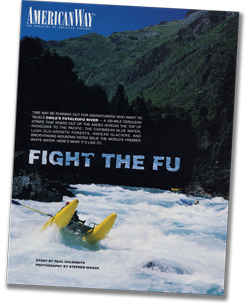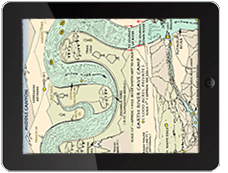"Paddle!"
"Come on, grab water," Eric yells from the rear of the boat. I'm jerked back to reality. No this isn't the North Atlantic or some scene from The Perfect Storm. This is Chile's Futaleufu river, the world's premier white water according to many. My four paddle mates and I are right in the middle of one of the wildest rapids we've faced, Casa de Piedra (stone house). Eric Hertz, our river guide and president of Earth River Expeditions, is directing us around a rock the size of my garage. For some reason, at that moment, I find myself taking perverse pleasure in the realization that I haven't checked my e-mail in six days. I can't even remember the last time I looked in the mirror. And I don't care. I lean out over the bow of our raft, laughing like some half-mad figurehead, and drive my paddle down into the silver froth. The current under the boat is pulling hard to the middle of the river, where a hole that could swallow a small car is waiting. "Back paddle!" Eric yells. And we do, like a well-oiled (but frantic) machine. Then we power ahead into a series of crashing waves. And then it's over - our last rapid.
Welcome to Patagonia and Chile's pristine Rio Futaleufu, a 100-mile-long cerulean stripe that roars out of the Andes with unbridled fury from Argentina, across the top of Patagonia to the Pacific. For the last two decades, the Fu has been a well-guarded secret among the elite rafters and kayakers of the world and rightly so. But the Fu's future might be in jeopardy. Chile has few environmental policies to protect such wild places and plans for damming the Futaleufu to provide hydroelectric power have been floating around for more than a decade. Time may be running out for this awesome river that offers Caribbean blue water, lush old-growth forests, Andean glaciers, breathtaking vistas, and wilder rapids than most North American rivers (like the Colorado through the Grand Canyon). "If one canyon contained the best rapids from North America's classic rivers, it would not equal the Futaleufu," says Hertz. And he should know. His company, Earth River Expeditions, pioneered the Fu, making the first commercial raft trips in the winter of 1992, and has since established itself as one of the premier rafting companies in the world. It runs rafting expeditions on the world's wildest rivers, from the Primrose in the Yukon to the world's deepest canyon of the Colca in Peru to China's Great Bend of the Yangtze. Hertz has been rafting for 28 years but still marvels at the Fu. "There is no greater combination of whitewater and beauty," he says. And that combination makes for one of hell of an adventure.
Lets face it, an increasing number of Americans have lost interest in spending their vacation relaxing on a beach somewhere or getting their thrills at amusement parks. All that time in conference rooms and cubicles has gone to our collective head and we need to get out in the air. More and more Americans are spending their vacation time hiking, or scuba diving, or whitewater rafting. The Travel Industry Association of America's first-ever adventure travel survey showed, incredibly, more that 50 percent of the the U.S. adult traveling population has taken an adventure trip in their lifetime. That's a staggering 147 million people-75-percent of those people in the past two years. As adventure travel continues to grow, it becomes harder and harder to really find true adventure anymore. The rivers and trails in many of our national parks are overrun by people who want a little visceral, outdoor experience, reducing them to not much more than parking lots with great scenery. Rafting the Colorado through the Grand Canyon can often be an exercise in patience, with a gridlock of motorized boats, crowds of people and a waiting list that stretches for decades. But that isn't the case on the Fu. Patagonia offers an incredible absence of people. The region barely has roads, let alone cars to contend with. Southern Chile is an undiscovered eco-travel paradise. The glacier-crowned peaks of the southern Andes dominate every view and rival the majesty of the Rocky mountains.Small rivers and streams offer unparalleled trout fishing. Primeval forests are everywhere. "Its' like Switzerland. It's like the Grand Tetons. It's so many places rolled into one," says Aileen Steinberg, a retiree from North Carolina joining us on the trip. But once you get a glimpse of the clear turquoise river, it immediately becomes the center of attention.
I was a little wary at first when I heard Earth River's Fu trip described as "The World's Wildest, Most Comfortable River Trip." The word comfortable threw me. Not that I was looking to be uncomfortable on my seven days in Patagonia, but I also didn't want to be insulated from the wild I came in search of. I didn't want to be catered, waited on hand and foot. I wanted to get wet. I wanted butterflies in my stomach. I wanted adrenaline. I soon found out I had nothing to fear.
My journey began in the fishing town of Puerto Montt, a three-hour flight south from Santiago, where I met my fellow rafters. We were an interesting group. A banker and his wife, three lawyers, a biology teacher, and entrepreneur, and an entire family, it's members ranging in age from 15 to 74. One group member was six months pregnant. From there we caught a small 19 passenger plane for our flight south along the coast - the massive 800,000 acre Pumalin Park stretched out beneath us on the left side of the plane - all old growth and fjord. We landed in the village of Chaiten, a place more outpost than town, and headed into the mountains. A three-hour drive later (amazingly without passing a single car), we found ourselves at the first of Earth River's private camps, 300 acres of meadow and forest perched 100 feet over the Fu, dominated by the imposing Tres Monjas (the "Three Nuns"), a seven thousand vertical - foot mountain topped with three towering granite spires. The camp comes equipped with showers, a kitchen, tents and a wonderful wood-burning hot tub, but once I crested the bluff and saw the Fu waiting below, nothing else seemed to matter. The river was all I could think about. The first thing I noticed was the color. In its more tranquil spots, the Fu is a deep blue-green - like the crayon color a child might imagine for water. When the canyon walls close on the river like a vise, the water mixes with pure white froth to become almost a pastel sea foam-green, the kind you see on hot rods. The river itself boasts 12 class five rapids, the wildest rapids considered safe to raft. These rapids with names like Infierno, Purgatorio, and Terminator, demand to be taken seriously. "Terminator is the epitome", says David Kashinski a river guide who has spent 14 years guiding boats through the Grand Canyon, Mexico and Belize, and now guiding the Fu. "The consequences are huge."
It was rapids like Terminator and Infierno that prevented a raft descent of the river until 1991. An attempt to raft the Fu in 1986 almost ended tragically when one of the rafts was torn to pieces by the river. Hertz and Earth River made the first complete raft descent in 1991, and the first commercial descent the following year. Thanks to a new kind of raft, designed by Hertz and his invention of the safety cataraft, those early descents and every Earth River trip since were without incident. Hertz is obsessed with the safety of his customers, constantly drilling customers about what to expect and how to handle it. Hertz also designed custom made safety catarafts for the Fu that stay with the boats in case any paddler is ejected.
We put in our first morning five miles from the Argentine border, just above Infierno Canyon. The morning was warm, hot even but the water was cold, so we donned wetsuits. For the next two hours, our 18 foot inflatable raft thundered through a series of rapids - Infierno, Purgatorio, Danza de lo Angles (Dance of the Angels). On our final rapid, a violent Class Five names Escala de Jacoba ("Jacob's Ladder"), our boat was sucked into a hole with such force that Eric, our guide, was thrown from the back of the boat. Amazingly, we all kept our heads, letting Eric's training regimen take over instead. We paddled the boat into an eddy while Eric Swam to shore. "It's 100 percent adventure, and yet it feels 100 percent safe," says, Kim Carter, a businessman from Bermuda and one of my paddle mates, while we waited in the eddy for Eric to rejoin us. We pushed off again, the day's rapids behind us, and drifted leisurely for the rest of the afternoon. When I finally get tired of counting the craters, I go off to bed. I close my eyes and drift off, the booming Fu singing me to sleep.



